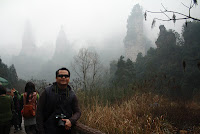A spectacular area stretching over more than 26,000 ha in China's Hunan Province, the site is dominated by more than 3,000 narrow sandstone pillars and peaks, many over 200 m high. Between the peaks lie ravines and gorges with streams, pools and waterfalls, some 40 caves, and two large natural bridges. In addition to the striking beauty of the landscape, the region is also noted for the fact that it is home to a number of endangered plant and animal species. The site lies in the Wulingyuan District of the city of Dayong and covers the entire dra inage basin of the Suoxi Brook, which winds for 69 km through the site. The most notable feature, dominating about two-thirds of the site, are more than 3,000 quartzite sandstone pillars and peaks. Between the peaks are numerous ravines and gorges, many containing attractive streams, pools and waterfalls. The site also contains a number of karst features, notably some 40 caves which are concentrated on the banks of the Suoxiyu River and the...



